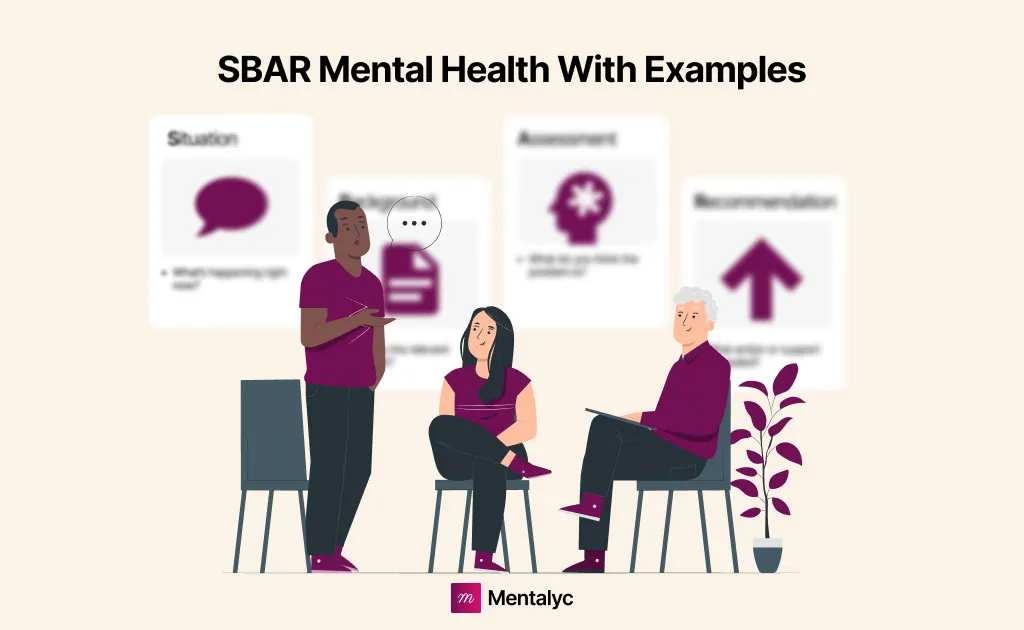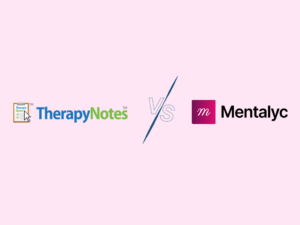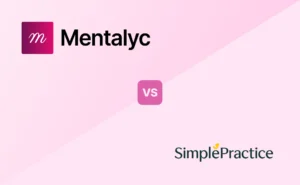Many therapists find it tricky to share detailed updates without losing nuance or drowning in jargon. That’s where the SBAR framework (Situation, Background, Assessment, Recommendation) comes in.
In this guide, we’ll break down how to use SBAR in mental health, share real examples, and show you how it can strengthen collaboration across your care team.
If you’re looking for a simpler way to document and collaborate with your team, Mentalyc helps you organize notes with structure and clarity – so your documentation stays compliant, consistent, and easy to share.
What is SBAR and Why Does It Matter in Mental Health?
Mental health professionals have adapted the SBAR framework, originally developed for physicians, to improve communication and coordination of care. SBAR (Situation, Background, Assessment, Recommendation) provides a simple way for mental health professionals to communicate critical client information and treatment plans during handoffs, referrals, or emergencies.

New! Transfer your notes to EHR with a single click. No more copy-pasting.
By using this structured approach, clinicians reduce misunderstandings, promote client safety, and enhance accurate communication across care teams.
The Four Components of SBAR

| SBAR Component | Description | Clinical Application in Mental Health |
| Situation | Clearly state the client’s current issue or concern in one or two sentences. | Used by mental health professionals to quickly convey critical client updates or safety concerns during shift handoffs or consultations. |
| Background | Provide relevant psychiatric, medical, and social history related to the situation. | Helps clinicians use psychiatric assessment frameworks to present accurate background data, including diagnosis, medication history, and psychosocial context. |
| Assessment | Summarize clinical impressions, observed behaviors, and identified risks. | Encourages use of clinical communication tools to analyze symptoms and risk levels, improving clarity in interdisciplinary discussions. |
| Recommendation | Offer evidence-based next steps or treatment suggestions. | Guides behavioral health documentation and ensures actionable, solution-oriented recommendations are communicated effectively. |
Example of each component:
Situation: What seems to be the issue?
For example, “I’m calling about my client, a 45-year-old male with schizophrenia and depression who was admitted yesterday.”
Background: What is the relevant background information?
For example, “My client has a 20-year history of schizophrenia and depression. He takes Olanzapine and Sertraline but stopped taking them two weeks ago. He lives alone and has limited social interaction.”
Assessment: What do you think is going on with the client?
For example, “My client presented with disorganized thoughts, paranoia, and suicidal ideation. His depression and hallucinations seem uncontrolled off medications.”
Recommendation: What do you suggest should be done to address the issue?
For example, “I recommend restarting my client’s medications, increased monitoring, and group therapy.”
How to Use the SBAR Tool for Effective Communication
When creating an SBAR report using the SBAR tool for mental health professionals, follow these steps:
Gather the Situation and Background
First, gather the relevant details about the client and their current situation. Ask yourself:
What is the client’s diagnosis or presenting problem?
What is their mental health history? Treatment history?
What life events lead up to their current state? Family, health, or work stressors?
Assess the Client’s Needs
Next, assess the client’s acute needs and risks. Consider things like:
Their symptoms and severity. Are they in crisis?
Safety risks like suicidal thoughts or self-harm.
Ability to care for themselves (hygiene, eating, sleeping).
Medication compliance and side effects.
Recommend an Action Plan
Finally, determine recommendations to address the client’s needs. This may include:
Scheduling more frequent sessions.
Adjusting medications or dosages.
Safety precautions like hospitalization or removing access to means of self-harm.
Referrals to other practitioners like a psychiatrist.
Community resources for extra support.
Additional Tips to Further Improve Your SBAR Communication Skills
Practice using SBAR regularly with teammates and providers to build confidence with the format.
Collect all necessary information before communicating. Gather data from charts, tests, and observations.
Use templates and checklists as reminders of the SBAR components.
Review client cases and role-play SBAR with coworkers for practice and feedback.
After communicating, confirm the receiver’s understanding by asking them to repeat the salient points.
Periodically self-assess your SBAR skills and identify areas for improvement.
Seek feedback from others on how effectively you follow the SBAR format and provide helpful information.
The Benefits and Limitations of the SBAR Communication Tool for Mental Health Practitioners
While it can be used to optimize client care outcomes, it may only sometimes be effective in complex cases. To achieve the best results, mental health practitioners should balance the structured benefits of SBAR with flexibility and discretion.
Benefits
SBAR in mental health is an effective tool that enhances communication and teamwork among all care team members. This reduces the risk of missing important information, which can negatively impact treatment and lead to confusion and delays in client care.
SBAR helps minimize miscommunication due to differences in professional jargon between different disciplines.
SBAR communication is concise yet thorough so clinicians can quickly grasp the situation.
For new practitioners, SBAR provides a helpful framework for learning practical communication skills.
The SBAR format provides a structured and concise way to communicate client information to other healthcare team members.
SBAR streamlines mental health handoff communication and reduces the time needed to relay critical client information. This is helpful in time-sensitive situations where quick action is required.
Limitations
Some clinicians may find the SBAR format too rigid or time-consuming, requiring a change in communication patterns.
SBAR also does not replace sound clinical judgment. Relying too heavily on the SBAR tool without applying critical thinking can lead to crucial oversights.
SBAR does not cover non-verbal aspects of communication that can impact message clarity, such as tone of voice and body language. These social cues are still essential to convey urgency or emphasize key points.
It may oversimplify complex clients or miss secondary issues.
Clinicians must review all relevant client data, not just recent information, and verify recipients understand the SBAR content.
Proper training on SBAR for therapists is needed to understand its purpose and limitations fully.
SBAR in Action: Case Examples of Depression and Schizophrenia (Mental Health SBAR Examples)
When discussing mental health concerns, the SBAR tool is an invaluable resource. Let’s see SBAR in use for two typical conditions: depression and schizophrenia.
SBAR Communication Mental Health Examples
SBAR example for Depression #1
Situation: A 37-year-old female is experiencing a severe depressive episode. The client reports sadness, worthlessness, and hopelessness over the past six weeks.
Background: No previous history of depression. Recently, she lost her job and ended a long-term relationship. She feels isolated and unable to cope.
Assessment: Meets DSM-5 criteria for Major Depressive Disorder, single episode, severe. The client is at high risk of self-harm.
Recommendation: Hospitalize the client for inpatient treatment, including medication and therapy. Provide 24-hour observation and support.
Depression Example #2
Situation: A 65-year-old male with a history of treatment-resistant depression. Currently experiencing worsening depressive symptoms.
Background: The client has a 20-year history of depression. He has been on multiple antidepressants and has received ECT in the past with minimal response. Current symptoms include decreased appetite, sleep disturbances, lack of interest in activities, and feelings of hopelessness.
Assessment: The client’s depression appears to have entered an acute phase with worsening chronic depressive symptoms and a lack of response to previous interventions.
Recommendation: Recommend a genetic test to identify gene variants that may predict response to specific antidepressants. Adjusting medication based on genetic information may improve treatment outcomes for this client with treatment-resistant depression.
SBAR example for Schizophrenia #1
Situation: A 41-year-old male exhibiting disorganized and delusional thinking. He believes he is receiving special messages through the TV and radio. Has become increasingly withdrawn and agitated.
Background: The client was diagnosed with schizophrenia two years ago and has been inconsistent with prescribed medication. The family reports that the client has not left the house in over a week and is not bathing or eating regularly.
Assessment: Acute psychotic episode due to noncompliance with antipsychotic medication. The client lacks insight into illness and is unable to care for self.
Recommendation: Hospitalize the client for inpatient treatment to stabilize the condition. Restart and adjust medications under supervision. Provide structured support and therapy to improve insight and self-care skills before transitioning to outpatient treatment.
Schizophrenia Example #2
Situation: A 23-year-old female with schizophrenia was brought to the emergency room by police after being found wandering the streets and talking to herself.
Background: The client was diagnosed with schizophrenia three years ago and has a history of medication noncompliance. She has been living on the streets for the past six months and has not followed up with her treatment team.
Assessment: The client is experiencing an acute exacerbation of schizophrenia symptoms due to a lack of medication and a stable living situation. She is disorganized, delusional, and paranoid.
Recommendation: Admit the client to the inpatient psychiatric unit for stabilization. Restart antipsychotic medication under supervision. After symptoms improve, arrange for supportive housing and connect the client with community mental health services to improve medication adherence and promote recovery. Regular check-ins and case management will be essential to prevent future hospitalizations.
SBAR in Mental Health vs Traditional Communication
| Aspect | SBAR Communication | Traditional Communication |
| Structure | Follows a clear, standardized order (Situation, Background, Assessment, Recommendation). | Often unstructured and varies by individual clinician style. |
| Focus | Centers on clarity, brevity, and clinical relevance | May include irrelevant or incomplete details, leading to confusion. |
| Team Coordination | Enhances communication across interdisciplinary healthcare teams by promoting a shared language and understanding. | Can result in miscommunication or duplication of effort among professionals. |
| Patient Outcomes | Supports patient safety and quality improvement by reducing errors and ensuring timely interventions. | Lacks standardization, which may increase the risk of overlooked information or delayed care. |
| Documentation Quality | Integrates well with electronic records and behavioral health documentation systems for consistency. | Inconsistent note-taking practices may hinder continuity of care and data accuracy. |
Conclusion
The SBAR framework remains one of the most effective ways for mental health professionals to communicate clearly and confidently. It streamlines information sharing, reduces misunderstandings, and supports smoother collaboration across care teams. With regular use, SBAR becomes more than a checklist. It turns into a habit that helps you present client information with focus and precision.
If you’re ready to bring that same clarity into your documentation, Mentalyc can help. Designed for therapists, it captures key session details and organizes them in a way that reflects your clinical reasoning — making every note as clear and confident as your communication.
Try Mentalyc for free and see how simple, accurate documentation can enhance both your note quality and your care.
Frequently Asked Questions (FAQs) About SBAR in Mental Health
Here are some frequently asked questions and answers regarding the SBAR in mental health:
What Is SBAR in Mental Health?
SBAR (Situation, Background, Assessment, Recommendation) is a structured communication framework designed to standardize how mental health professionals share clinical information. In mental health settings, it helps clinicians succinctly present essential client details, such as symptoms, risks, and treatment updates, to other providers. The situation background assessment recommendation model ensures clarity, reduces errors, and promotes consistent care delivery across teams.
Therapists and counselors can use an SBAR template for counselors to organize case summaries, particularly when coordinating with psychiatrists, nurses, or case managers. This concise format allows professionals to communicate efficiently while maintaining accuracy and empathy in client discussions.
What Is the Main Purpose of the SBAR Tool?
The main purpose of the SBAR tool is to improve communication between healthcare professionals by providing a clear, organized way to share important client information. It ensures that details are conveyed accurately and efficiently, reducing misunderstandings and supporting better client care.
Why SBAR Matters in Psychiatric Practice?
In psychiatric practice, SBAR plays a crucial role in improving clinical handoff communication, especially during transitions between therapists, psychiatrists, or inpatient and outpatient settings. Using SBAR communication in psychiatric nursing, clinicians can clearly convey a client’s mental status, treatment response, and safety concerns, ensuring continuity of care.
This model supports patient safety and mental health by minimizing misunderstandings that could lead to missed warning signs or delayed interventions. It also promotes interprofessional collaboration in behavioral health, allowing multidisciplinary teams to align on goals, treatment plans, and crisis management strategies.
How do I complete an SBAR?
To complete an SBAR, follow these steps:
Situation : Briefly state the client’s condition, symptoms, and recent status changes. For example, “Mr. Lindon is a 45-year-old male with schizophrenia experiencing worsening auditory hallucinations over the past week.”
Background: Provide relevant information, including medical and psychiatric history, recent life events, and current medications or treatments. For example, “Mr. Lindon has a 15-year history of schizophrenia. Mr. Lindon was stable on oral medications for several years but recently lost his job and health insurance. He has not taken his medications in over a month.”
Assessment: Analyze the situation and background to determine the severity and implications. For example, “Mr. Lindon’s lack of medication and worsening symptoms put him at high risk of hospitalization, self-harm, or harming others. His condition seems to be deteriorating rapidly.”
Recommendation: Propose appropriate recommendations to address the issues identified in the assessment. For example, “I recommend Mr. Lindon to be assessed immediately for inpatient psychiatric hospitalization and treatment.”
How to Use the SBAR Framework Effectively?
To use SBAR effectively, clinicians should:
Situation – Start with a concise statement about the client’s current issue or reason for communication.
Background – Provide relevant psychiatric and social history, medications, and recent events influencing the client’s condition.
Assessment – Offer your professional judgment based on current symptoms, observations, and risk factors.
Recommendation – Suggest actionable next steps or interventions, such as medication review, increased monitoring, or therapy adjustments.
Practicing the model during team meetings or consultations enhances confidence and clarity. When used consistently, SBAR strengthens clinical documentation and continuity of care, ensuring every professional involved in the case has accurate, up-to-date information for effective decision-making.
The framework also supports psychiatric assessment and recommendation processes by guiding clinicians to think systematically and communicate findings precisely, an essential skill in both individual therapy and multidisciplinary treatment planning.
When would I use an SBAR?
SBAR is ideal for efficiently communicating critical client information in time-sensitive situations or during provider handoffs. It is commonly used when:
Consulting with physicians or nurse practitioners about a client’s condition or treatment.
Transferring a client from one provider or care setting to another.
Discussing a client’s status during shift changes or between providers.
Requesting orders, medications, or resources for a client.
How should I complete an SBAR when communicating over the phone?
When using SBAR over the phone, concisely and only provide the most relevant information. Start with the situation, then background, assessment, and recommendation. Speak slowly and clearly. Ask the listener to repeat back key details to confirm accuracy.
What are some examples of situations in mental health that require SBAR communication?
Psychiatric emergencies like suicidal or homicidal thoughts
Severe medication side effects
Rapid changes in mood, behavior, or cognition
Changes in living situation, support system, or life stressors
How to Practice and Improve SBAR Skills as a Clinician?
Practice using SBAR with colleagues to discuss real or mock client cases. Request feedback to identify areas for improvement. Over time, aim to reduce the time it takes you to deliver an effective SBAR. Keep a record of the SBARs you provide to track your progress.
What should I include in the ‘Recommendation’ section of an SBAR for a client with suicidal thoughts?
You should recommend immediate actions to ensure the client’s safety and potentially life-saving interventions like a psychiatric evaluation, hospitalization, and suicide prevention strategies.
When would I use SBAR to communicate with a client’s family members?
SBAR can effectively communicate important information to family members during transitions of care, changes in the client’s condition, or when seeking information from family to aid in the client’s treatment.
Resources:
Brenner, B. (2021, April 25). What is SBAR, and Why is It Important? MEDPRO Disposal, LLC. https://www.medprodisposal.com/what-is-sbar-and-why-is-it-important/
Shahid, S., & Thomas, S. (2018). Situation, Background, Assessment, Recommendation (SBAR) Communication Tool for Handoff in Health Care – A Narrative Review. Safety in Health, 4(1). https://doi.org/10.1186/s40886-018-0073-1
SBAR | ASQ. (n.d.). Asq.org. https://asq.org/quality-resources/sbar
SBAR Handover in Patient Safety: advantages and disadvantages – CAREFUL. (2022, September 13). Careful. https://careful.online/sbar-handover/
SBAR | Turas | Learn. (n.d.). Learn.nes.nhs.scot. https://learn.nes.nhs.scot/3408
Tool: SBAR | Agency for Healthcare Research and Quality. (n.d.). https://www.ahrq.gov/teamstepps-program/curriculum/communication/tools/sbar.html
Why other mental health professionals love Mentalyc

“By the end of the day, usually by the end of the session, I have my documentation done. I have a thorough, comprehensive note … It’s just saving me hours every week.”
CDCII

“Having Mentalyc take away some of the work from me has allowed me to be more present when I’m in session with clients … it took a lot of pressure off.”
LPC

“It’s so quick and easy to do notes now … I used to stay late two hours to finish my notes. Now it’s a breeze.”
Licensed Professional Counselor

“It takes me less than 5 minutes to complete notes … it’s a huge time saver, a huge stress reliever.”
Licensed Marriage and Family Therapist






